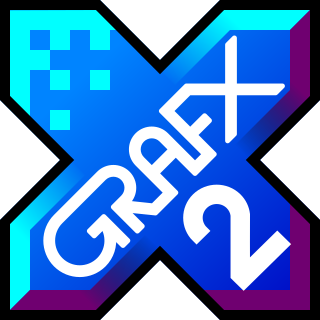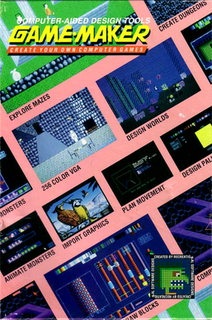
Adobe Photoshop is a raster graphics editor developed and published by Adobe Inc. for Windows and macOS. It was originally created in 1988 by Thomas and John Knoll. Since then, the software has become the industry standard not only in raster graphics editing, but in digital art as a whole. The software's name is often colloquially used as a verb although Adobe discourages such use. Photoshop can edit and compose raster images in multiple layers and supports masks, alpha compositing and several color models including RGB, CMYK, CIELAB, spot color, and duotone. Photoshop uses its own PSD and PSB file formats to support these features. In addition to raster graphics, Photoshop has limited abilities to edit or render text and vector graphics, as well as 3D graphics and video. Its feature set can be expanded by plug-ins; programs developed and distributed independently of Photoshop that run inside it and offer new or enhanced features.
GRASS is a programming language created to script 2D vector graphics animations. GRASS was similar to BASIC in syntax, but added numerous instructions for specifying 2D object animation, including scaling, translation and rotation over time. These functions were directly supported by the Vector General 3D graphics terminal GRASS was written for. It quickly became a hit with the artistic community who were experimenting with the new medium of computer graphics, and is most famous for its use by Larry Cuba to create the original "attacking the Death Star will not be easy" animation in Star Wars (1977).

Deluxe Paint, often referred to as DPaint, is a bitmap graphics editor series created by Dan Silva for Electronic Arts. The original Deluxe Paint was written for the Commodore Amiga 1000 and released in November 1985. It was eventually ported to other platforms, including an MS-DOS version which became the standard for pixel graphics in video games in the 1990s, the only competitor being Autodesk Animator Pro.

Interleaved Bitmap (ILBM) is an image file format conforming to the Interchange File Format (IFF) standard. The format originated on the Amiga platform, and on IBM-compatible systems, files in this format or the related PBM format are typically encountered in games from late 1980s and early 1990s that were either Amiga ports or had their graphical assets designed on Amiga machines.
Autodesk 3ds Max, formerly 3D Studio and 3D Studio Max, is a professional 3D computer graphics program for making 3D animations, models, games and images. It is developed and produced by Autodesk Media and Entertainment. It has modeling capabilities and a flexible plugin architecture and must be used on the Microsoft Windows platform. It is frequently used by video game developers, many TV commercial studios, and architectural visualization studios. It is also used for movie effects and movie pre-visualization. For its modeling and animation tools, the latest version of 3ds Max also features shaders, dynamic simulation, particle systems, radiosity, normal map creation and rendering, global illumination, a customizable user interface, new icons, and its own scripting language.

Microsoft Paint is a simple raster graphics editor that has been included with all versions of Microsoft Windows. The program opens and saves files in Windows bitmap (BMP), JPEG, GIF, PNG, and single-page TIFF formats. The program can be in color mode or two-color black-and-white, but there is no grayscale mode. For its simplicity and that it is included with Windows, it rapidly became one of the most used applications in the early versions of Windows, introducing many to painting on a computer for the first time. It is still widely used for simple image manipulation tasks.

Non-photorealistic rendering (NPR) is an area of computer graphics that focuses on enabling a wide variety of expressive styles for digital art, in contrast to traditional computer graphics, which focuses on photorealism. NPR is inspired by other artistic modes such as painting, drawing, technical illustration, and animated cartoons. NPR has appeared in movies and video games in the form of cel-shaded animation as well as in scientific visualization, architectural illustration and experimental animation.

Kid Pix is a bitmap drawing program designed for children. Originally created by Craig Hickman, it was first released for the Macintosh in 1989 and subsequently published in 1991 by Broderbund. Hickman was inspired to create Kid Pix after watching his son Ben struggle with MacPaint, and thus the main idea behind its development was to create a drawing program that would be very simple to use.
Raster graphics editors can be compared by many variables, including availability.

Pixologic ZBrush is a digital sculpting tool that combines 3D/2.5D modeling, texturing and painting. It uses a proprietary "pixol" technology which stores lighting, color, material, orientation, and depth information for the points making up all objects on the screen. The main difference between ZBrush and more traditional modeling packages is that it is more akin to traditional sculpting.
Project Dogwaffle is a raster graphics editor with animation capabilities.

LOGO.SYS is a core system file used by Windows 9x operating systems to display its boot-up message.

The First Samurai, alternatively titled First Samurai, is a 1991 beat 'em up platformer developed by Vivid Image and published by Image Works. The First Samurai was originally released in September 1991 for the Amiga and Atari ST, and was later ported to the Commodore 64, MS-DOS and the Super Nintendo Entertainment System. It was followed by a sequel, Second Samurai.

3D computer graphics, sometimes called CGI, 3DCGI or three-dimensional computer graphics, are graphics that use a three-dimensional representation of geometric data that is stored in the computer for the purposes of performing calculations and rendering 2D images. The resulting images may be stored for viewing later or displayed in real time. Unlike 3D film and similar techniques, the result is two-dimensional, without the illusion of being solid.

PCPaint was the first IBM PC-based mouse-driven GUI paint program. It was developed by John Bridges and Doug Wolfgram. It was later developed into Pictor Paint.
This article deals with productivity software created for the Amiga line of computers and covers the AmigaOS operating system and its derivates AROS and MorphOS and is a split of main article Amiga software. See also related articles Amiga Internet and communications software, Amiga music software, Amiga programming languages, and Amiga support and maintenance software for other information regarding software that run on Amiga.
Animation of Scalable Vector Graphics, an open XML-based standard vector graphics format, is possible through various means:

GrafX2 is a bitmap graphics editor inspired by the Amiga programs Deluxe Paint and Brilliance. It is free software and distributed under the GPL-2.0-or-later license.
Fatpaint is a free, online (web-based) graphic design and desktop publishing software product and image editor. It includes integrated tools for creating page layout, painting, coloring and editing pictures and photos, drawing vector images, using dingbat vector clipart, writing rich text, creating ray traced 3D text logos and displaying graphics on products from Zazzle that can be purchased or sold. Fatpaint integrates desktop publishing features with brush painting, vector drawing and custom printed products in a single Flash application. It supports the use of a pressure-sensitive pen tablet and allows the user to add images by searching Wikimedia, Picasa, Flickr, Google, Yahoo, Bing, and Fatpaint's own collection of public domain images. The completed project can be saved on Fatpaint's server or locally. Fatpaint is affiliated with Zazzle and owned by Mersica.

Game-Maker is an MS-DOS-based suite of game design tools, accompanied by demonstration games, produced between 1991 and 1995 by the Amherst, New Hampshire based Recreational Software Designs and sold through direct mail in the US by KD Software. Game-Maker also was sold under various names by licensed distributors in the UK, Korea, and other territories including Captain GameMaker and Create Your Own Games With GameMaker!. Game-Maker is notable as one of the first complete game design packages for DOS-based PCs, for its fully mouse-driven graphical interface, and for its early support for VGA graphics, Sound Blaster sound, and full-screen four-way scrolling.












